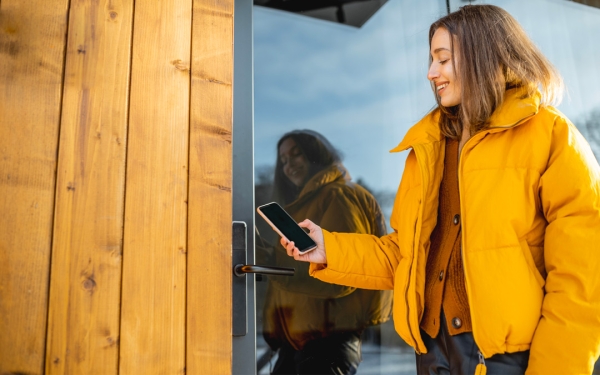Smart door locks are not new to Hotels, but thanks to the continuous advancements in their IoT technology they are among the most cutting-edge trends in the Hospitality industry, allowing guests to access their smart rooms using just their smartphones.

Guest room door locks have evolved into sophisticated technology. Guests have always expected their door locks to offer security, reliability, efficiency, and convenience. Guests do not typically give door locks much thought unless the locks fail to meet their expectations.
The next evolution in guest expectations is contactless check-in and keyless door access. As part of a larger trend in Hotel loyalty apps, the guest uses the Hotel’s mobile app to check-in without the inconvenience of visiting the front desk. With this mobile access, the guest can proceed directly to his or her room, using directions provided by the app. Once arriving at their smart room, the guest brings the device close to the door lock, and the door automatically unlocks.
The now-traditional Hotel keycards are of course still used throughout the world, and they offer similar benefits of security, reliability, efficiency, and convenience. In 2017 Hilton boasted that they had had 11 million digital key uses that year without a single security breach, and many Hotels now use “bank-level security” for their locks with 128-bit encryption.
This smart technology has already begun to be adopted by Hotels, and we are excited to see how this technology continues to innovate.
EMS Integration
Integrating smart door locks into an Energy Management platform means maintaining and enhancing current electronic door locks by allowing them – along with guest room controls – to communicate within an EMS platform of thermostats, occupancy sensors, and light switches over a secure network.
In a similar scenario, when the guest presents a mobile phone to the door, the door recognizes that the person entering is a guest and not housekeeping. The guest inserts a key card into the door to unlock it. The lock sends a “guest entered” message to the thermostat via Zigbee. Along with the thermostat controller’s PIR sensor, this assists in determining room occupancy. The smart thermostat forwards this message to the EMS. Perhaps guest room lighting controls are activated.
When the guest checks out, another message is sent to the door lock.
The door locks can also issue alerts, update keycards, and communicate events like “door ajar”. With smart door lock technology, Hotels can restrict guests from accessing specific areas like the penthouse floor, staff rooms, and kitchens.
When the locks ride on an Energy Management platform, it eliminates the need for separate network infrastructure, reducing redundancy and cost. These benefits are extremely valuable to Hotel owners.
Future Trends
Technology that is still in its infancy in terms of Hotel adoption, Apple has opened its ‘Apple Wallet’ app to Hotels for keyless guest room entry. Hyatt Hotels Corp. is now piloting this feature. ‘Apple Wallet’ can also store airline boarding passes, dinner reservations, food delivery, etc.
In the future, we anticipate that guests will have the ability to keep their mobile devices in their pockets or purses and unlock the guestroom door just by bringing it in close proximity to the door, similar to today’s digital car keys.
As IoT continues to innovate, the future of guest room controls in Hospitality is bright. Not only can we meet guests’ stringent expectations, but we can surprise and delight them with features they have not yet even conceived of!